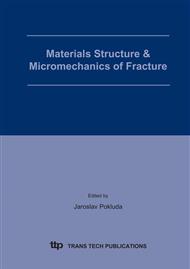p.295
p.299
p.303
p.307
p.311
p.315
p.319
p.323
p.327
On the Crack Tip Shielding in Particle Reinforced Composites
Abstract:
The paper is focused on crack-tip shielding effects caused by crack deflection (tilting) processes in particle reinforced composites. A numerical analysis by means of the ANSYS code was employed in order to assess these effects caused by rigid particles and holes in the matrix. As the first step, the effective stress intensity factor Keff was calculated for many crack tip positions in front, and in between, two particles of the same kind. In spite of a significant crack tip tilting, the spherical holes induce a slight increase in the Keff factor (anti-shielding). On the other hand, the rigid particles cause a significant decrease in the Keff-value (shielding), while leaving the crack practically unaffected. In the second step, the effect of particles in the wake of the crack tip will be analyzed in order to obtain a complex picture of shielding.
Info:
Periodical:
Pages:
311-314
DOI:
Citation:
Online since:
April 2005
Authors:
Price:
Сopyright:
© 2005 Trans Tech Publications Ltd. All Rights Reserved
Share:
Citation:


